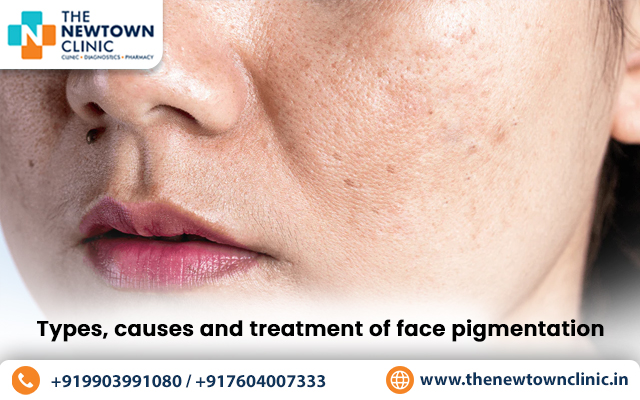Learn about the types, causes and treatment of face pigmentation from the skin doctors at the best dermatology clinic in New Town.
Facial pigmentation is a common concern affecting individuals, manifesting as dark patches or discolouration on the face and neck. While freckles can be charming, larger, unevenly coloured patches may indicate underlying issues. The leading dermatologist at the best dermatology clinic in Newtown discusses the various types of facial pigmentation, their causes, the influence of genetic and environmental factors, and effective preventive measures and treatments.
Types of Facial Pigmentation:
- Freckles (UV-induced hyperpigmentation): Freckles result from excess melanin production triggered by prolonged exposure to sunlight. Genetics play an important role in influencing the propensity for freckle development. UV rays cause DNA damage within melanocytes, leading to the formation of ephelides or freckles pigmentation.
- Melasma (Hormonally Induced Pigmentation): Melasma, a pigmentation type caused by hormonal fluctuations, is prevalent in about 30% of women. Hormonal contraception, hormone replacement therapy, or pregnancy can induce excess melanin production.
- Post-Inflammatory Hyperpigmentation (PIH): PIH results from trauma, injury or inflammation, increasing melanin synthesis and deposition. Common in darker skin tones, PIH manifests as brown pigmentation due to the presence of melanin, particularly after acne breakouts.
- Solar Lentigo – Age or Liver Spots: Solar lentigo, often termed age or liver spots, arises from prolonged sun exposure, triggering melanocytes to accumulate melanin within keratinocytes. These well-defined, dark patches typically develop after the age of 40 in shades of black, brown, or tan.
- Post-Inflammatory Erythema (PIE): PIE is identified by purplish, pinkish or reddish patches resulting from acne inflammation affecting blood flow. Common in acne-prone and lighter skin tones, PIE signifies the aftermath of acne breakouts.
Common Causes of Pigmentation:
- Prolonged Sun Exposure: Excessive exposure to sunlight stimulates melanin production, resulting in pigmentation. UV rays cause damage to skin components, prompting melanocytes to release more melanin for protection.
- Hormonal Changes: Fluctuations in hormones during puberty, pregnancy, or due to contraceptive pills can disrupt the skin’s balance, leading to hyperpigmentation like Melasma.
- Ageing: As the skin ages, it loses its ability to produce melanin, making it susceptible to dark spots when exposed to UV rays. Solar lentigos may develop as a result.
- Underlying Medical Conditions: Certain medical conditions, such as Addison’s disease or hemochromatosis, can manifest as facial pigmentation extending beyond the face and neck to other body parts.
- Unhealthy Diet: A diet high in sugary foods with a high glycemic index can contribute to hyperpigmentation. Sugar’s collagen-deconstructing effects may affect skin elasticity.
- Drugs and Medications: Certain drugs, including NSAIDs, hormone replacement therapy drugs, and antibiotics, may cause facial pigmentation as a side effect.
- Harsh Chemicals in Skincare Products: Toxic chemicals in cosmetics or skincare products can disrupt the natural melanin composition of the skin, leading to pigmentation issues.
- Acne Breakouts: Acne breakouts often result in post-inflammatory hyperpigmentation, as the skin releases excess melanin to defend against infections.
Prevention and Protection:
- Sunscreen: Regular use of sunscreen with at least SPF 30 and water-resistant properties helps shield the skin from harmful UV rays.
- Include Vitamin C: Vitamin C serums can correct discolouration and pigmentation, promoting bright, hydrated skin.
- Hydrate and Exfoliate: Maintain a moisturised skin care routine to promote healthy, pigmentation-free skin.
- Choose Skin-Friendly Ingredients: Opt for products with ingredients like liquorice and vitamin C for tyrosinase inhibition and reduced pigmentation.
Treatment Options:
- Dark Spot Treatment: Skin-brightening treatments, like those offered by the New Town Clinic, can lighten pigmentation patches, providing even-toned and hydrated skin.
- Skin Whitening Treatment: One of the best facial treatments for addressing pigmentation caused by acne, sun damage or freckles, this treatment rejuvenates the skin, reducing melanin production for a naturally radiant complexion.
- Skin Polishing Treatment/Microdermabrasion: This procedure removes the top skin layer, smoothing and enhancing skin tone while effectively treating pigmentation marks and acne scars.
- Chemical Peels: The New Town Clinic offers chemical peels with varying strengths to address pigmentation, promote skin renewal, and reveal a fresh, radiant complexion.
Facial pigmentation, with its various types and causes, can significantly impact skin appearance. Understanding these factors allows individuals to adopt preventive measures and seek professional treatments at the best dermatology clinic when needed.

